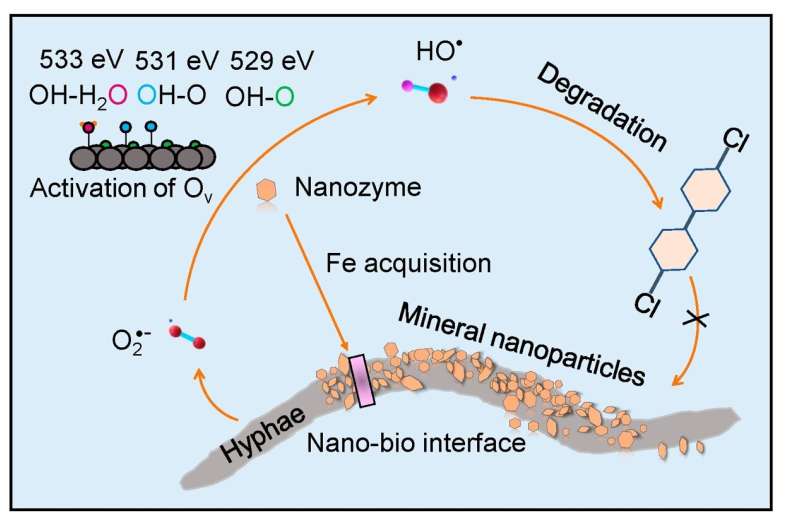

| Date | 26th, Sep 2023 |
|---|
 At the interface of nano-biology, fungi trigger the creation of oxygen vacancies on mineral surfaces via biomineralization. This process, in turn, propels the activity of mineral nanozymes, leading to the degradation of organic pollutants. Credit: Science China Press
At the interface of nano-biology, fungi trigger the creation of oxygen vacancies on mineral surfaces via biomineralization. This process, in turn, propels the activity of mineral nanozymes, leading to the degradation of organic pollutants. Credit: Science China Press
A study led by Dr. Guanghui Yu from School of Earth System Science, Tianjin University, delved into the role of magnetite nanoparticles as nanozyme mimics.
Employing the model white rot fungus Phanerochaete chrysosporium, Le Chang and Guanghui Yu investigated the degradation of 4,4′-dichlorobiphenyl (PCB15) with and without the presence of magnetite nanoparticles. Notably, the addition of these nanoparticles substantially bolstered the breakdown of PCB15 by Phanerochaete chrysosporium, with degradation rates reaching 42% and 84% after 3 and 5 days of co-cultivation, respectively.
Microscopic assessments of fungal-mineral samples were further performed by Le Chang and Guanghui Yu at the National Protein Science Research Facility's Beamline BL01B within the Shanghai Synchrotron Radiation Facility (SSRF). They observed magnetite particles adhering tightly to fungal hyphae, exhibiting uneven distribution on hyphal surfaces.
Intrigued by the mechanisms underlying the fungal-magnetite synergy in pollutant degradation, Le Chang and Dr. Guanghui Yu identified that magnetite nanoparticles displayed enzyme-like activity, labeling them as "nanozymes." This discovery suggested an inherent nanozymatic activity within magnetite nanoparticles.
Noteworthy was the finding that co-cultivation of the fungus with magnetite nanoparticles significantly augmented the nanozymatic activity of the nanoparticles. Statistical analysis revealed a strong negative correlation (r=−0.96, p
